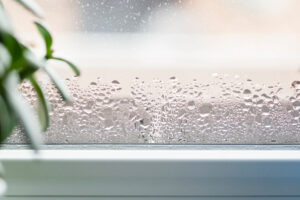
Condensation can be a real nightmare in a property and, at its every worst, will cause damage to the property and also be an ideal growing ground for mould which brings with it some serious and potentially fatal health hazards. In this informative article we will take a look at how condensation forms, why condensation is an issue, the most common sources of condensation and how to prevent it.

How does condensation form?
Condensation forms when warm air, laden with moisture hits a cold surface such as a window. The change in temperature causes the moisture in the air to condense back to water on the surface. The most common places for condensation to form are windows, tiled areas, external walls (especially the colder north facing walls) and doors.
Why is condensation a problem?
Surely condensation can’t be that bad, can it? It is after all only water and water is a natural part of life. Whilst that is true, condensation does cause serious problems in properties from significant property damage to causing serious health hazards.
Property damage
If not dealt with, the water formed from condensation can penetrate into woodwork, making it rotten, soften and it will destroy plaster, cause wallpaper to peel off, cause damage to carpets and cause paint to peel. All of which will need to be repaired or things will just get worse.
Condensation as a health hazard
Fungi like nothing more than warm, damp places with plenty of food. When condensation forms on internal surfaces these exact conditions are created and mould will grow. Mould spores, when released into the air can enter the occupants’ airways and lungs and cause some pretty serious lung problems. This is made even worse if the person already suffers with Asthma or COPD. These lung conditions can be fatal.
What are the most common causes of condensation
The biggest culprits are baths and showers. These release large amounts of warm moisture into the air. They aren’t the only culprits though. Other causes of condensation are:
- Any cooking which involves boiling water like cooking rice or potatoes will release moisture into the air
- Boiling a kettle
- Drying clothes on radiators or clothes horses
- Poor tumble drier venting
How to Prevent condensation
Condensation can be easily prevented. The main thing is ventilation. Ventilation essentially moves the moist air out of your home. Ensure that, when showering or bathing, that you either have a window open or an extractor fan running. This will allow the water laden air to escape. If you use an extractor, make sure it runs on after you leave the bathroom as the air will still be very damp.
Cover pots and pans when boiling water and, if you have one, turn on the extraction fan in the kitchen or open the windows. Again, this allows wet air to escape. Do not cover air bricks. Whilst they do allow the cold in, they are there for a very important reason and they allow good airflow in and out of your home. If you block these, it is more likely that condensation will form.
Try not to dry your clothes inside, if you have to then use a well vented tumble drier. If you do not have a tumble drier, we would recommend putting the clothes in the smallest room, closing the door and putting in a dehumidifier. The dehumidifier will remove water from the air caused by drying the clothes.
If you do get condensation and the steps above don’t 100% eradicate it, make sure that the water is removed quickly and isn’t allowed to settle for too long.
Condensation can cause some pretty serious property damage and damage to health in the long term, so preventing condensation and making sure your home is well ventilated is the key to condensation control.



